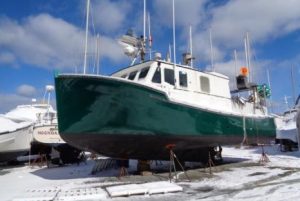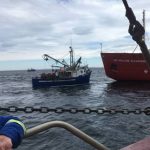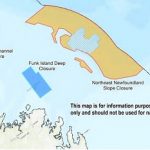Category Archives: Marine Science
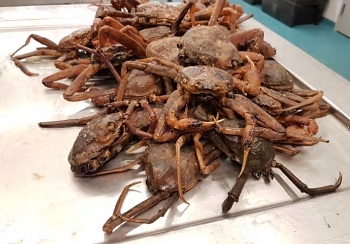
DFO warns 80% of N.L. snow crab are below fishable size
Eighty per cent of the snow crab in the province’s waters are now smaller than fishable size, and new biological research from the Department of Fisheries and Oceans says fishing pressure on the already strained stock is the main problem. “There is a major biological concern here,” said DFO biologist Darrell Mullowney.,, The news comes just as the Department of Fisheries and Oceans is set to meet with harvesters about snow crab in a series of meetings being held across the province between November 19 and 29. >click to read<19:44

Oh, Give Me a Home Where the Wild Cod Roam
It took a week for Björn Björnsson to train 20 wild cod. In a compelling demonstration of classical conditioning, the aquaculture researcher at Iceland’s Marine and Freshwater Research Institute taught the fish to associate a low-frequency sound with a free meal. It only took another day for Björnsson—with the help of one of his trained fish—to teach another 19 wild cod. People might not think of cod as herd animals, but Björnsson says cod are adept at reading social cues to learn where to grab a bite. >click to read<12:10

Oceanographers produce first-ever images of entire cod shoals
For the most part, the mature Atlantic cod is a solitary creature that spends most of its time far below the ocean’s surface, grazing on bony fish, squid, crab, shrimp, and lobster—unless it’s spawning season, when the fish flock to each other by the millions,forming enormous shoals that resemble frenzied, teeming islands in the sea. >click to read<14:33

Killer Whale Populations At Risk from Toxic Chemicals
A paper in the Sept. 28 issue of Science says killer whales are at great risk, but not from climate change, loss of habitat or loss of their prey. It will be due to something that sounds very 1970s – PCB, or polychlorinated biphenyl. PCBs are human-made chemicals used for making plastics, electronics, lubricants, heat transformers and other materials and technology. In the late 1970s, studies showed the harmful effects of PCB on humans and on wildlife, such as birds, otters and seals. According to a 2017 paper, killer whale populations off the coast of the most industrialized parts of Europe are close to extinction. >click to read<12:02

Chile purse seine project nominated for conservation award
In October, the Pink-footed Shearwaters begin to arrive on Robinson Crusoe Island, off the coast of Chile. “These [fishing fleets] are fishing in the same areas as these birds. They are capturing the very fish these seabirds eat,” said Cristian Suazo, a member of the Albatross Task Force Chile, which is working to combat bycatch. “The fleets are also out at the same time these birds, many of which are migratory, have the greatest need for food to both refuel and to feed their young.”,,, In Chile, the ATF has been working since 2007, where it began by trying to reduce bycatch in pelagic longline fisheries. In 2013 though, the team noted that there was also bycatch coming from purse seine fisheries, and began working to reduce bycatch in this industry as well. >click to read<17:43
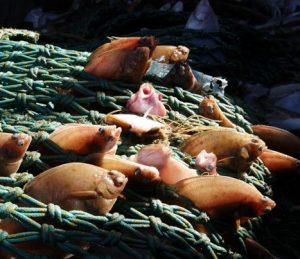
Wait, So How Much of the Ocean Is Actually Fished?
How much of the world’s oceans are affected by fishing? In February, a team of scientists led by David Kroodsma from the Global Fishing Watch published a paper that put the figure at 55 percent—an area four times larger than that covered by land-based agriculture. The paper was widely covered, with several outlets leading with the eye-popping stat that “half the world’s oceans [are] now fished industrially.” Ricardo Amoroso from the University of Washington had also been trying to track global fishing activity and when he saw the headlines, he felt that the 55 percent figure was wildly off. He and his colleagues re-analyzed the data that the Global Fishing Watch had made freely available. And in their own paper, published two weeks ago, they claim that industrial fishing occurs over just 4 percent of the ocean. How could two groups have produced such wildly different answers using the same set of data? >click to read<21:21
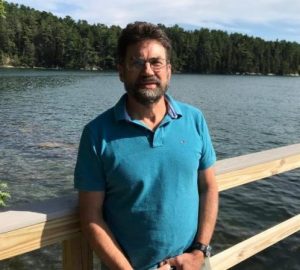
Wahle named director of the Lobster Institute at the University of Maine
University of Maine marine sciences research professor Richard Wahle has been named director of the University of Maine’s Lobster Institute, effective Sept. 1. He succeeds Robert Bayer, who has directed the institute since 1995 and is retiring from UMaine this year. Wahle joined UMaine’s School of Marine Sciences in 2009. He is based at the University’s Darling Marine Center, where he will continue to teach and conduct research. In 1989, Wahle founded the American Lobster Settlement Index, a program that now monitors the number of juvenile lobsters that settle to the seafloor at over 80 sampling sites from Rhode Island to Atlantic Canada. The index sheds light on the ocean processes that deliver lobster larvae to their rocky coastal nurseries, and serves as a predictor of trends in recruitment to the fishery. >click to read<10:36

Epizootic Shell Disease – New findings suggests earlier springs and hotter summers foster increase in shell infections
New findings reveal that as coastal waters in the northeastern U.S. continue to warm — bottom temperatures in Long Island Sound have increased 0.7°F per decade over the last 40 years — resident lobsters are becoming increasingly susceptible to epizootic shell disease, a condition that has depleted the southern New England population and severely impacted the local lobster fishery.,,, As the name implies, epizootic shell disease occurs when the bacterial populations that normally inhabit the surface of a lobster’s carapace change and begin consuming the cuticle, causing it to erode. >click to read<09:18
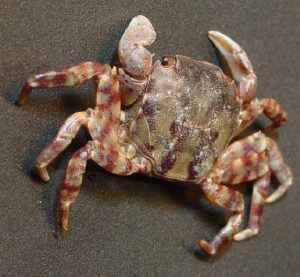
Narragansett Bay – Invasive Asian Crab Outcompeting Young Lobsters
Speculation about the cause of the decline of lobster populations in Narragansett Bay has focused on an increasing number of predatory fish eating young lobsters, warming waters stressing juveniles, and a disease on their shells that is exacerbated by increasing temperatures. A new study by a scientist at the University of North Carolina points to another contributing factor: Asian shore crabs.,,, Adult lobsters live in much deeper water than the shallow intertidal zone inhabited by Asian shore crabs, so the two species seldom interact. But some larval lobsters settle in the intertidal and subtidal zones, which they use as nursery habitat. Prior to the arrival of Asian shore crabs, it was an area that had fewer predators and an abundance of food. But now the young lobsters are finding themselves in competition with the crabs for food and shelter. >click to read<09:25

Once in a blue moon: Crabber catches rare all-blue blue crab
Jim McInteer and his crew mate Alan Payne knew they had captured an oddity the moment they pulled their crab pot from the York River last Tuesday. “We were excited about it,” says McInteer. “Alan yelled, ‘Come look at this crab!’ He very carefully took him out of the pot and then I could see exactly what it was — I’d read about how they occur every now and then, so we knew what we had.” McInteer, who at 73 has been crabbing commercially for 10 years and recreationally for decades, says he’s caught blue crabs “with blotches of white, and some other slight discolorations, but never a solid-blue blue crab.”Recognizing its rarity, they donated it to the laboratory of Professor Rom Lipcius, an expert in crustacean ecology at William & Mary’s Virginia Institute of Marine Science. >click to read<16:19

10-foot white shark accidentally caught off Massachusetts coast – Utilized for Science
The Atlantic White Shark Conservancy shared photos of a white shark, described as a 10-foot, 657-pound immature female, that was captured unintentionally on Saturday. The animal was caught and killed by a gill net, or a fishing device that hangs vertically to capture and trap fish by their gills. The shark was brought back to Scituate where scientists from the Massachusetts Division of Marine Fisheries and NOAA New England could take samples for research purposes. An online report from “Massachusetts Sharks” said researchers found the remains of seal and a striped bass in the shark’s stomach. >click to read<17:20
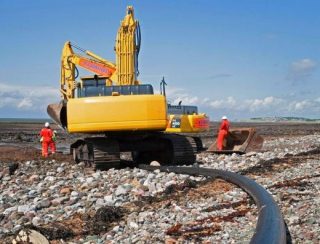
Undersea Power Cables – Electromagnetic fields have complex and possibly harmful effects on the valuable brown crab.
Over the past 10 years, Scotland has installed thousands of offshore wind turbines in the North Sea and is starting to deploy marine energy devices that generate power from tides and waves. It’s a green energy push that is slowly being replicated in coastal areas the world over. Though these installations are reducing coastal threats such as oil spills, they have the potential to cause other, more subtle, problems for marine life. From each offshore wind and tidal turbine, power cables snake to shore, connecting to power banks, converters, and the wider electrical grid. But these electrified cables could have odd and unexpected effects on seafloor life. >click to read<08:43

Whale News – Rare right whale last seen in Cape Cod Bay spotted in Iceland, Southern resident Orca calf dies soon after birth
A right whale last seen off Marshfield has turned up in Iceland. An Icelandic whale watch tour spotted the critically endangered mammal on Monday. Mogul, the 10-year-old male North Atlantic right whale, was last seen in Cape Cod Bay April 21. >click to read< Mogul the right whale’s appearance off Iceland puzzles scientist >click to read< Meanwhile, The first calf born in three years to the endangered orcas that spend time in Pacific Northwest waters died Tuesday – >click to read< Alexandra Morton Press release – Baby Orca death could be linked to salmon farm virus >click to read< NOAA prioritizing West Coast Chinook salmon stocks for Southern Resident killer whale recovery >click to read<09:27

Bay lobster aquaculture developed in Tasmania
The Institute for Marine and Antarctic Studies (IMAS), under the University of Tasmania, has paved the way for the bay lobster (Thenus oriental) aquaculture industry in Tasmania, after developing a unique method to breed the resource commercially. Based at IMAS’s Taroona laboratories, the ARC Research Hub for Commercial Development of Rock Lobster Culture Systems began researching hatchery techniques for the resource, better known as Moreton Bay Bugs, in September 2017. The starting point for this project was the technique developed for the tropical rock lobster, of the Panulirus family. >click to read<15:24

The impossible journey of the juvenile coho
As a Ph.D. student with the University of Washington’s Alaska Salmon Program, Jonny Armstrong — now assistant professor at Oregon State University’s Fish and Wildlife Department — snorkeled the Wood River in the Bristol Bay watershed. He soon encountered a mystery: juvenile coho as much as a mile from the nearest sockeye spawning ground had sockeye eggs in their stomachs. Sockeye lay their eggs in cold water, where there’s lots of oxygen. A juvenile coho, however, doesn’t best digest sockeye eggs in that water — cold slows its digestion, meaning if it stayed there, it might need a week to process just one meal. >click to read<22:38

Cocaine in the Water Is Hurting River Eels
The Earth’s waters are laced with drugs—from prescription and over-the counter medications, to caffeine, to antibiotics from personal care products. Marine environments are also tainted with illegal drugs, and a recent study demonstrates just how harmful these illicit substances can be to aquatic wildlife. As Michael Marshall reports for New Scientist, researchers in Italy have found that small amounts of cocaine in water can make eels hyperactive and cause significant muscle damage. >click to read<16:41

Dead plankton, stunned fish: the harms of man-made ocean noise
Human-caused ocean noise and its dangers to marine life are the focus of meetings at the United Nations this week, a victory for advocacy groups that have long warned of this problem. What are the causes of ocean noise? The main human activity that causes noise is maritime shipping. Among the loudest sounds are explosions aimed at demolishing offshore oil platforms, though these events are rare. Advocacy groups focus on seismic airguns, which are used by oil and gas interests to find reserves on the ocean floor. A boat tows 12-48 airguns at a time, each of which shoot loud blasts of compressed air. >click to read<15:27

Giant great white ate its cousin during Sandbridge research expedition
When a Virginia Institute of Marine Science longline fishing survey caught a black tip shark on Friday, a much larger white shark couldn’t turn down an easy meal. Researchers just three and a half miles off Sandbridge were reeling in their 1.2-mile longline, equipped with 100 baited hooks, last week when a 12- to 13-foot great white showed up to see what all the fuss was about.,,VIMS began studying sharks in the mid-Atlantic in 1973 with its Shark Survey. It’s one of the longest running studies of shark populations in the world. The survey has shown a serious decline in shark numbers because of overfishing. That discovery led to the first shark management plan by NOAA Fisheries in 1993. >click to read<12:28

Three New Species Of Warm-Blooded Fish Discovered
Scientists have found three more species of a fish that – despite what we are taught at school – are fully warm-blooded. The species in question are large deep-sea fish known as opah, and are found in many oceans around the planet. A few years ago, the opah made headlines when it was revealed to be the first fully warm-blooded fish species ever discovered. Living in the frigid waters of the deep ocean, it warms its blood by continuously flapping its fins to generate heat. This keeps the fish’s core temperature at about 4 to 5°C (7.2-9°F) >click to read<16:22

23year Old Lady Born Without Vagina Has One Made Out Of Fish Skin (Photos)
A 23-year-old university student who was born without a vagina, has become the first in the world to undergo pioneering surgery that constructed a new vaginal canal out of fish skin. According to Mirror, the operation took place at the Federal University of Ceara (UFC), Brazil. The girl was diagnosed in her teens with having no cervix, uterus, ovaries or womb. Jucilene Marinho has now spoken for the first time and talked about how the revolutionary operation using skin of the tilapia fish has changed her life and allowed her to have sex for the first time. >click to read<11:43

Don Cuddy: Mattapoisett company moving fishing tech forward
Sometimes a chat over a fence is all it takes to set great things in motion. Fairhaven resident Karl Edminster was talking with his neighbor, marine researcher Emily Keiley, when she mentioned that SMAST had an underwater cable that had suffered damage on a fisheries survey cruise. She knew Karl’s job had something to do with electrical work. He said he’d take a look. In fact, Karl is the president of Elecrtromechanica, a high tech design and build engineering outfit based in Mattapoisett. They spliced the cable. “But we told them we do more than fix cables,” >click to read<15:04

Lost Crab Pots: Not as Bad as We Thought?
Back in 2016, a team of scientists from the Virginia Institute of Marine Science said watermen lost an astounding number—145,000 crab pots, leading to the deaths of millions of dollars’ worth of crabs trapped in those pots. But a different panel of scientists says it’s not as bad as they originally thought. Glenn Davis, who chairs the Chesapeake Bay Stock Assessment Committee, told a winter meeting of fisheries managers that the VIMS numbers are wrong.,,, But once the VIMS study was out there, it was hard to take back. And sure enough, somebody tried to monetize it.>click to read<09:05

Estimating similarity in benthic communities over decades and in areas open and closed to fishing in the central Gulf of Maine
ABSTRACT: The ledges and banks of the central Gulf of Maine (i.e. Fippennies Ledge, Jeffreys Ledge, Cashes Ledge, and Platts Bank) have supported groundfish and Atlantic sea scallop fisheries for centuries. The benthic community of Fippennies Ledge was evaluated and compared during 2 time periods separated by more than 2 decades, the first based on a series of photographs collected during manned submersible dives conducted in 1986 and 1987 and the second using photographs collected during drop camera video surveys conducted in 2009 to 2014. >click to read<21:08
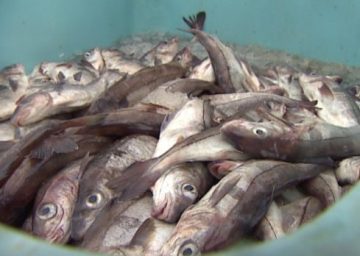
DFO stock assessment – Halibut and Haddock flourishing, cod struggling
Wild food fish populations off Atlantic Canada continue to confound scientists, with some species flourishing and others floundering. The latest examples are halibut and cod. The big flatfish is flourishing off Nova Scotia and Newfoundland, according to the latest stock assessment released by the Department of Fisheries and Oceans. However, another new DFO report shows cod stocks off southern Nova Scotia remain in dire shape.,,,Yellow flounder is another species that is struggling. >click to read< 14:56











































